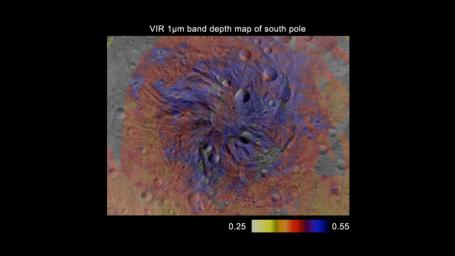
|
Pyroxene Map of Vesta’s South Pole
- Click the image above for a larger view
- Full-Res JPEG (1280 x 720) (75.1 kB)
- Full-Res TIFF (1280 x 720) (2.8 MB)
Caption:
This map, made from data obtained by NASA's Dawn spacecraft, shows the distribution of pyroxene, an iron- and magnesium-rich mineral, in the southern hemisphere of the giant asteroid Vesta. The data come from Dawn's visible and infrared mapping spectrometer, using the 1 micron wavelength filter as a proxy for the proportion of pyroxene. The areas in purple have a higher proportion of pyroxene, indicating excavation of the crust by impacts that have revealed deeper layers.
Background Info:
The Dawn mission to Vesta and Ceres is managed by NASA's Jet Propulsion Laboratory, a division of the California Institute of Technology in Pasadena, for NASA's Science Mission Directorate, Washington. UCLA is responsible for overall Dawn mission science. The visible and infrared mapping spectrometer was provided by the Italian Space Agency and is managed by Italy's National Institute for Astrophysics, Rome, in collaboration with Selex Galileo, where it was built.
More information about Dawn is online at http://www.nasa.gov/dawn and http://dawn.jpl.nasa.gov .
Cataloging Keywords:
| Name | Value | Additional Values |
|---|---|---|
| Target | 4 Vesta | |
| System | Main Belt | |
| Target Type | Asteroid | |
| Mission | Dawn | |
| Instrument Host | Dawn | |
| Host Type | Orbiter | |
| Instrument | Visible and Infrared Spectrometer (VIR) | |
| Detector | ||
| Extra Keywords | Color, Impact, Infrared, Map | |
| Acquisition Date | ||
| Release Date | 2012-05-10 | |
| Date in Caption | ||
| Image Credit | NASA/JPL-Caltech/UCLA/INAF | |
| Source | photojournal.jpl.nasa.gov/catalog/PIA15672 | |
| Identifier | PIA15672 | |
